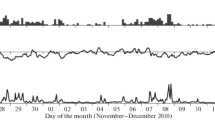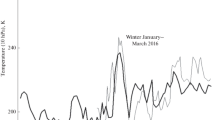Summary
In order to investigate the effect of increased solar ultraviolet radiation on total atmospheric ozone, ozone observations have been made during sudden ionospheric disturbances (S. I. D.). If one can assume that the ratio of the extraterrestrial intensity of sunlight at 3110 Å to that at 3300 Å (the wavelengths observed by the measuring instrument) remains unchanged during days with S. I. D., it is found that ozone changes associated with S. I. D. s are small or absent, in agreement with qualitative theoretical expectation.
Zusammenfassung
Um die Auswirkung einer Zunahme der ultravioletten Sonnenstrahlung auf das atmosphärische Ozon zu untersuchen, wurden beim Auftreten desMögel-Dellinger-Effekts (Sudden Ionospheric Disturbances, S. I. D.) Ozonmessungen angestellt. Unter der Annahme, daß an den Tagen mit S. I. D. das Verhältnis der Intensität der extraterrestrischen Sonnenstrahlung bei 3110 Å zu der bei 3300 Å konstant bleibt, findet man, daß die gleichzeitigen Ozonänderungen entweder sehr klein sind oder ganz fehlen, was in Übereinstimmung mit dem theoretisch zu erwartenden Verhalten ist.
Résumé
Pour examiner l'effet de croissance de la radiation solaire ultraviolette sur l'ozone total atmosphérique, des mesures de l'ozone ont été faites pendant certains jours avec des perturbations ionosphériques brusques (Sudden Ionospheric Disturbances, S. I. D.) qui apparaissent ordinairement simultanément avec une éruption solaire. Si l'on suppose que le quotient de l'intensité extra-terrestre du rayonnement solaire pour λ-3110 Å à celle pour λ=3300 Å est constant, on constate que les variations de l'ozone coïncidentes avec les S. I. D. sont petites ou manquent complètement ce qui est en bon accord qualitatif avec la théorie.
Similar content being viewed by others
References
Craig, R. A.: The observations and photochemistry of atmospheric ozone and their meteorological significance. American Meteorological Society. Meteorological Monographs1, No. 2, (Sept. 1950). 50 pages.
Fritz, S. andG. C. Stevens: Atmospheric ozone at Washington, D. C. Mon. Weath. Rev.78, 135 (1950).
Central Radio Propagation Laboratory: Ionospheric Data, CRPL-F Series, National Bureau of Standards, Washington, D. C.
Mitra, S. K.: The Upper Atmosphere. 1948, Royal Asiatic Society Bengal, Calcutta (see p. 306).
Wulf, O. R. andL. S. Deming: On the production of the ionospheric regions E and F and the lower altitude ionization causing radio fade-outs. Terr. Mag. Atm. El.43, 283 (1938).
Ramanathan, K. R. andR. V. Karandikar Effect of dust and haze on measurements of atmospheric ozone made withDobson's Spectrophotometer. Qu. J. R. Met. Soc.75, 257 (1949).
International Astronomical Union: Qu. Bull. on Solar Act., Nos. 82–86 (April 1948-June 1949).
Author information
Authors and Affiliations
Additional information
With 4 Figures.
Rights and permissions
About this article
Cite this article
Fritz, S. Ozone measurements during sudden ionospheric disturbances. Arch. Met. Geoph. Biokl. A. 4, 343–350 (1951). https://doi.org/10.1007/BF02246812
Issue Date:
DOI: https://doi.org/10.1007/BF02246812




